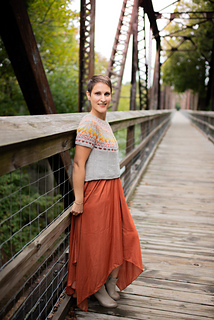patterns >  Kate Oates and 1 more...
Kate Oates and 1 more...
> Lovebirds Sweater













Lovebirds Sweater
A little birdie told me…that you need him on a sweater with his true love! Inspired by the Lovebirds Cowl, this array of geometric colorwork is worked seamlessly from the top down with yoked increases & short row shaping both at the shoulders and the bottom. The gentle A-line shape of the body combined with extra length at the hem complements curvy and straight body types alike. Options are provided for two different Body and Sleeve styles: classic stockinette or a simple cable along with short or long Sleeve lengths. Instructions are provided to work Body inside out for less purling, if desired. Shown in Size M with 1.5” (4 cm) positive ease; 1-4” (2.5-10 cm) ease is recommended. Colorwork is charted. Because a few rounds feature longer floats, this pattern is recommended for knitters with prior stranded colorwork experience.
Be sure to check out all the fabulous test projects, such a beautiful variety of yarn combinations and project options on incredible knitters! Scroll all the way down for some helpful links and thoughts from me. Featured sweater shows Wilder in the Light Grey and Dyed in the Wool in Sunset Strip.
Join Kate’s Mailing List to stay in touch and enjoy exclusive subscriber promos.
SIZE
XXS (XS, S, M, M/L){L, XL, 2X}(3X, 4X, 5X)
FINISHED CHEST
29 (32.25, 35.5, 38.75, 42){45.25, 48.5, 51.75}(55, 58.25, 61.5)“/74 (82, 90.5, 98.5, 106.5){115, 123, 131.5}(139.5, 147.5, 156) cm
GAUGE
26 sts and 31 rows per 4”/10 cm in stranded colorwork on larger needles; 24 sts per 4”/10 cm in Reverse Slip Cable and stockinette on larger needles
YARN
Cap Sleeves: 650 (725, 825, 900, 1000){1100, 1200, 1300}(1400, 1475, 1550) yards/ 595 (665, 755, 825, 915){1005, 1100, 1190}(1280, 1350, 1420) meters A and 175 (200, 225, 250, 275){325, 350, 400}(450, 475, 500) / 160 (185, 205, 230, 250){300, 320, 375}(410, 435, 460) meters B sport weight yarn
Long Sleeves: 1075 (1200, 1275, 1400, 1500){1625, 1700, 1950}(2075, 2225, 2300) yards/ 985 (1100, 1165, 1280, 1375){1485, 1555, 1785}(1900, 2035, 2100) meters A and 175 (200, 225, 250, 275){325, 350, 400}(450, 475, 500) / 160 (185, 205, 230, 250){300, 320, 375}(410, 435, 460) meters B sport weight yarn
TOOLS
Size 3 (3.25 mm) circular needles and set of DPNs, Size 4 (3.5 mm) circular needles and set of DPNs, cable needles, stitch markers: a total of 19 (21, 23, 25, 27){29, 31, 33}(35, 37, 39) for Cabled Body ONLY or 3 for Stockinette Body ONLY plus 2 removable markers for Both Styles
Helpful links/tips for this project:
Cabling without a needle by Grumperina
Color Dominance by Ysolda
Calculating increases across a round by Alex Capshaw-Taylor
General Stranding Tips by Andrea Rangel
Catching Floats by Andrea Rangel (read my thoughts below!)
My thoughts on float catching: There are definitely a few rounds in this design where you’ll have long floats! It is absolutely up to you if you would like to catch the floats. I decided not to catch my floats with this sweater because it was only a few rounds and, when I’m putting a sweater over my head I don’t have a lot of things that it has an opportunity to get caught on. Also, I used wool yarn that, after not very long at all, will naturally felt a bit on the WS and take care of the float issue completely. If I was worried about it, I could do some gentle rubbing myself during blocking (however, I’m not, so I won’t!) The downside to catching floats is that sometimes you can see the wrapped float from the RS especially if there is a lot of contrast in your two colors. As with many things in knitting, there is really not a right or wrong answer to this! It is all personal preference. If long floats drive you crazy you should absolutely catch them. If they don’t, let them be and you’ll be just fine. If you’re on the fence, then I think this is a good project to try something new which could actually be in either direction because there aren’t a ton of rounds in which you’d be catching floats (or not). So, you could either practice the technique for the first time and see how you like it, OR skip the technique and see if it drives you crazy. How’s that for a non-answer answer? Link included above if you’d like to catch yours.

24821 projects
stashed
28219 times
783 projects
stashed
517 times
- First published: October 2019
- Page created: October 17, 2019
- Last updated: September 18, 2023 …
- visits in the last 24 hours
- visitors right now






